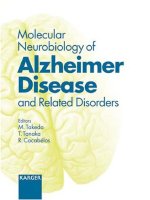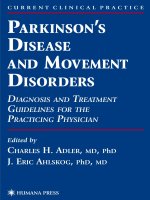somatoform and factitious disorders
Bạn đang xem bản rút gọn của tài liệu. Xem và tải ngay bản đầy đủ của tài liệu tại đây (1.19 MB, 200 trang )
Somatoform and
Factitious Disorders
Review of Psychiatry Series
John M. Oldham, M.D.
Michelle B. Riba, M.D., M.S.
Series Editors
No. 3
Washington, DC
London, England
Somatoform and
Factitious Disorders
EDITED BY
Katharine A. Phillips, M.D.
Note: The authors have worked to ensure that all information in this book
concerning drug dosages, schedules, and routes of administration is accurate as
of the time of publication and consistent with standards set by the U.S. Food and
Drug Administration and the general medical community. As medical research
and practice advance, however, therapeutic standards may change. For this
reason and because human and mechanical errors sometimes occur, we
recommend that readers follow the advice of a physician who is directly involved
in their care or the care of a member of their family. A product’s current package
insert should be consulted for full prescribing and safety information.
Books published by American Psychiatric Publishing, Inc., represent the views
and opinions of the individual authors and do not necessarily represent the
policies and opinions of APPI or the American Psychiatric Association.
Copyright © 2001 American Psychiatric Publishing, Inc.
04 03 02 01 4 3 2 1
ALL RIGHTS RESERVED
Manufactured in the United States of America on acid-free paper
First Edition
American Psychiatric Publishing, Inc.
1400 K Street, NW
Washington, DC 20005
www.appi.org
The correct citation for this book is
Phillips KA (editor): Somatoform and Factitious Disorders (Review of Psychiatry
Series, Volume 20, Number 3; Oldham JM and Riba MB, series editors).
Washington, DC, American Psychiatric Publishing, 2001
Library of Congress Cataloging-in-Publication Data
Somatoform and factitious disorders / edited by Katharine A. Phillips.
p. cm. — (Review of psychiatry ; v. 20, no. 3)
Includes bibliographical references and index.
ISBN 1-58562-029-7 (alk. paper)
1. Somatoform disorders. 2. Factitious disorders. 3. Medicine,
Psychosomatic.
I. Phillips, Katharine A. II. Review of psychiatry series ; v. 20, 3
[DNLM: 1. Somatoform Disorders. 2. Factitious Disorders. WM 170 S6927 2001]
RC552.S66 .S676 2001
616.89—dc21
00-067403
British Library Cataloguing in Publication Data
A CIP record is available from the British Library.
Cover illustration: Copyright © 2001 David Williams/Illustration Works.
Contents
Contributors ix
Introduction to the Review of Psychiatry Series xi
John M. Oldham, M.D., and
Michelle B. Riba, M.D., M.S., Series Editors
Foreword xv
Katharine A. Phillips, M.D.
Chapter 1
Somatization Disorder 1
Vicenzio Holder-Perkins, M.D.
Thomas N. Wise, M.D.
Evolution of Diagnostic Criteria 2
Epidemiology 7
Clinical Features 8
Etiologic Considerations 9
Differential Diagnosis 12
Evaluating the Patient with Somatization Disorder 13
Treatment Considerations 16
Conclusion 20
References 21
Chapter 2
Hypochondriasis 27
Brian A. Fallon, M.D.
Suzanne Feinstein, Ph.D.
Clinical Features 28
Theoretical Models 31
Treatment of Hypochondriasis 43
Conclusion 59
References 60
Chapter 3
Body Dysmorphic Disorder 67
Katharine A. Phillips, M.D.
History 67
Prevalence 68
Clinical Features 69
Etiology and Pathophysiology 76
Relationship With Other Disorders 76
Diagnosis 80
Treatment 81
Conclusion 88
References 88
Chapter 4
Conversion Disorder 95
José R. Maldonado, M.D.
David Spiegel, M.D.
Clinical Subtypes 97
History 101
Models of Symptom Generation 106
Functions Served by Conversion Symptoms 109
Associated Features 110
Epidemiology, Demographic Features, and
Disease Course 111
Comorbidity 114
Differential Diagnosis 115
Treatment 117
Conclusion 121
References 121
Chapter 5
Factitious Disorder 129
Marc D. Feldman, M.D.
James C. Hamilton, Ph.D.
Holly N. Deemer, M.A.
Epidemiology and Etiology 130
Diagnosis 133
Clinical Description 134
Associated Features 139
Prevalence 140
Costs 145
Limitations of Current Approaches 146
Etiology 149
Management 152
Conclusion 157
References 159
Afterword 167
Katharine A. Phillips, M.D.
Index 169
Contributors ix
Contributors
Holly N. Deemer, M.A.
Doctoral Candidate in Clinical Psychology, Department of
Psychology, University of Alabama, Tuscaloosa, Alabama
Brian A. Fallon, M.D.
Associate Professor of Clinical Psychiatry, Columbia University
College of Physicians and Surgeons, New York, New York; Director,
Somatic Disorders Treatment Program, New York State Psychiatric
Institute, New York, New York
Suzanne Feinstein, Ph.D.
Research Psychologist, New York State Psychiatric Institute, New
York, New York
Marc D. Feldman, M.D.
CPM Medical Director; Vice Chair, Clinical Services; and Associate
Professor, Department of Psychiatry and Behavioral Neurobiology,
University of Alabama at Birmingham, Birmingham, Alabama
James C. Hamilton, Ph.D.
Assistant Professor, Department of Psychology, University of
Alabama, Tuscaloosa, Alabama
Vicenzio Holder-Perkins, M.D.
Instructor, Department of Psychiatry, Georgetown University School
of Medicine, Washington, D.C.; Instructor, Department of Psychiatry,
George Washington University School of Medicine, Washington, D.C.
José R. Maldonado, M.D.
Assistant Professor of Psychiatry; Medical Director, Consultation/
Liaison Psychiatry; and Chief, Medical and Forensic Psychiatry,
Department of Psychiatry and Behavioral Sciences, Stanford
University School of Medicine, Stanford, California
John M. Oldham, M.D.
Dollard Professor and Acting Chairman, Department of Psychiatry,
Columbia University College of Physicians and Surgeons, New York,
New York
x SOMATOFORM AND FACTITIOUS DISORDERS
Katharine A. Phillips, M.D.
Associate Professor of Psychiatry and Human Behavior, Brown
University School of Medicine, Providence, Rhode Island; Associate
Medical Director, Ambulatory Care, and Director, Body Dysmorphic
Disorder Program, Butler Hospital, Providence, Rhode Island
Michelle B. Riba, M.D., M.S.
Associate Chair for Education and Academic Affairs, Department of
Psychiatry, University of Michigan Medical School, Ann Arbor,
Michigan
David Spiegel, M.D.
Professor of Psychiatry; Director, Psychosocial Treatment Laboratory;
and Director, Complementary Medicine Clinic, Department of
Psychiatry and Behavioral Sciences, Stanford University School of
Medicine, Stanford, California
Thomas N. Wise, M.D.
Professor, Department of Psychiatry, Georgetown University School
of Medicine, Washington, D.C.; Professor, Department of Psychiatry,
Johns Hopkins University School of Medicine, Baltimore, Maryland;
Medical Director, Behavioral Services, Inova Health Systems, Falls
Church, Virginia
Introduction to the Review of Psychiatry Series xi
Introduction to the Review
of Psychiatry Series
John M. Oldham, M.D., and
Michelle B. Riba, M.D., M.S., Series Editors
2001 REVIEW OF PSYCHIATRY SERIES TITLES
• PTSD in Children and Adolescents
E
DITED BY SPENCER ETH, M.D.
• Integrated Treatment of Psychiatric Disorders
E
DITED BY JERALD KAY, M.D.
• Somatoform and Factitious Disorders
E
DITED BY KATHARINE A. PHILLIPS, M.D.
• Treatment of Recurrent Depression
E
DITED BY JOHN F. GREDEN, M.D.
• Advances in Brain Imaging
E
DITED BY JOHN M. MORIHISA, M.D.
In today’s rapidly changing world, the dissemination of infor-
mation is one of its rapidly changing elements. Information vir-
tually assaults us, and proclaimed experts abound. Witness, for
example, the 2000 presidential election in the United States, dur-
ing which instant opinions were plentiful about the previously
obscure science of voting machines, the electoral college, and the
meaning of the words of the highest court in the land. For medi-
cine the situation is the same: the World Wide Web virtually bulg-
es with health advice, treatment recommendations, and strident
warnings about the dangers of this approach or that. Authoritative
and reliable guides to help the consumer differentiate between
sound advice and unsubstantiated opinion are hard to come by,
xii SOMATOFORM AND FACTITIOUS DISORDERS
and our patients and their families may be misled by bad infor-
mation without even knowing it.
At no time has it been more important, then, for psychiatrists
and other clinicians to be well informed, armed with the very lat-
est findings, and well versed in evidence-based medicine. We
have designed Volume 20 of the Review of Psychiatry Series with
these trends in mind—to be, if you will, a how-to manual: how to
accurately identify illnesses, how to understand where they come
from and what is going wrong in specific conditions, how to mea-
sure the extent of the problem, and how to design the best treat-
ment, especially for the particularly difficult-to-treat disorders.
The central importance of stress as a pathogen in major mental
illness throughout the life cycle is increasingly clear. One form of
stress is trauma. Extreme trauma can lead to illness at any age, but
its potential to set the stage badly for life when severe trauma oc-
curs during early childhood is increasingly recognized. In PTSD
in Children and Adolescents, Spencer Eth and colleagues review the
evidence from animal and human studies of the aberrations, both
psychological and biological, that can persist throughout adult-
hood as a result of trauma experienced during childhood. Newer
technologies have led to new knowledge of the profound nature
of some of these changes, from persistently altered stress hor-
mones to gene expression and altered protein formation. In turn,
hypersensitivities result from this early stress-induced biological
programming, so that cognitive and emotional symptom patterns
emerge rapidly in reaction to specific environmental stimuli.
Nowhere in the field of medicine is technology advancing
more rapidly than in brain imaging, generating a level of excite-
ment that surely surpasses the historical moment when the dis-
covery of the X ray first allowed us to noninvasively see into the
living human body. The new imaging methods, fortunately, do
not involve the risk of radiation exposure, and the capacity of the
newest imaging machines to reveal brain structure and function
in great detail is remarkable. Yet in many ways these techniques
still elude clinical application, since they are expensive and in-
creasingly complex to administer and interpret. John Morihisa
has gathered a group of our best experts to discuss the latest de-
velopments in Advances in Brain Imaging, and the shift toward
Introduction to the Review of Psychiatry Series xiii
greater clinical utility is clear in their descriptions of these meth-
ods. Perhaps most intriguing is the promise that through these
methods we can identify, before the onset of symptoms, those
most at risk of developing psychiatric disorders, as discussed by
Daniel Pine regarding childhood disorders and by Harold Sack-
eim regarding late-life depression.
Certain conditions, such as the somatoform and factitious dis-
orders, can baffle even our most experienced clinicians. As
Katharine Phillips points out in her foreword to Somatoform and
Factitious Disorders, these disorders frequently go unrecognized
or are misdiagnosed, and patients with these conditions may be
seen more often in the offices of nonpsychiatric physicians than
in those of psychiatrists. Although these conditions have been
reported throughout the recorded history of medicine, patients
with these disorders either are fully convinced that their prob-
lems are “physical” instead of “mental” or choose to present their
problems that way. In this book, experienced clinicians provide
guidelines to help identify the presence of the somatoform and
factitious disorders, as well as recommendations about their
treatment.
Treatment of all psychiatric disorders is always evolving, based
on new findings and clinical experience; at times, the field has
become polarized, with advocates of one approach vying with
advocates of another (e.g., psychotherapy versus pharmacother-
apy). Patients, however, have the right to receive the best treat-
ment available, and most of the time the best treatment includes
psychotherapy and pharmacotherapy, as detailed in Integrated
Treatment of Psychiatric Disorders. Jerald Kay and colleagues
propose the term integrated treatment for this approach, a recom-
mended fundamental of treatment planning. Psychotherapy alone,
of course, may be the best treatment for some patients, just as
pharmacotherapy may be the mainstay of treatment for others,
but in all cases there should be thoughtful consideration of a
combination of these approaches.
Finally, despite tremendous progress in the treatment of most
psychiatric disorders, there are some conditions that are stub-
bornly persistent in spite of the best efforts of our experts. John
Greden takes up one such area in Treatment of Recurrent Depres-
xiv SOMATOFORM AND FACTITIOUS DISORDERS
sion, referring to recurrent depression as one of the most dis-
abling disorders of all, so that, in his opinion, “a call to arms” is
needed. Experienced clinicians and researchers review optimal
treatment approaches for this clinical population. As well, new
strategies, such as vagus nerve stimulation and minimally inva-
sive brain stimulation, are reviewed, indicating the need to go
beyond our currently available treatments for these seriously ill
patients.
All in all, we believe that Volume 20 admirably succeeds in ad-
vising us how to do the best job that can be done at this point to
diagnose, understand, measure, and treat some of the most chal-
lenging conditions that prompt patients to seek psychiatric help.
Foreword xv
Foreword
Katharine A. Phillips, M.D.
The somatoform and factitious disorders are fascinating syn-
dromes that are beset with contradictions. They have an unusu-
ally long, rich, and colorful historical and clinical tradition, yet
some of them have received scant empirical investigation. Most
of the somatoform disorders appear to be relatively common in a
diverse array of clinical settings—psychiatric, primary care, and
specialty medical settings—yet they often go unrecognized and
undiagnosed. In addition, although the somatoform disorders are
grouped together in a separate diagnostic section of DSM-IV-TR,
they are unlikely to be closely related.
The somatoform disorders—somatization disorder, undiffer-
entiated somatoform disorder, conversion disorder, pain disor-
der, hypochondriasis, and body dysmorphic disorder (BDD)—
involve a focus on bodily/somatic complaints. A general medical
condition, substance use, or another mental disorder does not
fully account for the physical symptoms or concerns, and the
physical symptoms are not intentionally produced (unlike facti-
tious disorders). Although it is often said that the common fea-
ture of these disorders is the presence of physical symptoms that
suggest a general medical condition, this is not the case for BDD,
which instead consists of a preoccupation with a perceived ap-
pearance flaw. Factitious disorders are characterized by physical
or psychological symptoms, which, unlike the somatoform dis-
orders, are intentionally produced or feigned by the patient in or-
der to assume the sick role.
This book provides a clinically focused overview of these com-
plex disorders. Undifferentiated somatoform disorder (a residual
category for somatoform presentations that do not meet criteria
xvi SOMATOFORM AND FACTITIOUS DISORDERS
for somatization disorder or another somatoform disorder) is not
included. Pain disorder, which was included in Review of Psychi-
atry, Volume 19 (2000), is also excluded. Although factitious dis-
orders are classified in a separate section of DSM-IV-TR, they are
included here because they often consist of prominent somatic
symptoms, and in clinical settings they can be difficult to differ-
entiate from the somatoform disorders. Indeed, as discussed in
Chapter 5, the somatoform disorders and factitious disorder may
not be discrete and distinct, but may instead be on a continuum.
As the following chapters illustrate, most of the somatoform
disorders appear to be relatively common in psychiatric and oth-
er medical settings, although further studies of their prevalence
are needed. Some of these disorders present more often to primary
care physicians, neurologists, internists, dermatologists, and sur-
geons than to psychiatrists. Psychiatrists nonetheless often see
these patients, but because the presenting symptoms can be covert
(as in the case of BDD, for example) or unusually complex (when
attempting to differentiate seizures from pseudoseizures, for ex-
ample), the somatoform disorders may go unrecognized or be di-
agnosed incorrectly. The factitious disorders appear to be more
common in medical settings than is generally appreciated, and
they are among the most memorable and difficult cases that cli-
nicians encounter.
Most of the chapters in this book convey the unusually rich
history of somatoform and factitious disorders. The intriguing
symptoms with which patients present have captivated and
vexed clinicians for millennia. The Papyrus Ebers, an Egyptian
medical document that dates back to 1600
B.C., discussed “hyste-
ria,” a term previously used to describe somatoform symptoms.
Hippocrates, who believed that a wandering uterus caused pain
and disease in women, designed treatments such as body ban-
daging to restrict uterus movement. In medieval times, “major
hysteria” was explained by demonic possession. Some of the
most renowned physicians of recent centuries (e.g., Janet, Charcot,
Freud) labored to solve the many mysteries of these disorders.
Despite the consistent richness of their historical and clinical
tradition, somatoform and factitious disorders have received
variable, and in some cases limited, empirical investigation. One
Foreword xvii
exception is somatization disorder. For decades researchers have
applied an unusually careful and systematic approach to devel-
oping and refining the diagnostic criteria for this disorder, and
elegant family and adoption studies have been conducted. Re-
search on hypochondriasis has delineated its phenomenology,
comorbidity, and assessment, greatly advancing our understand-
ing of the disorder. Although systematic research on BDD has
only recently begun, our knowledge of this underrecognized dis-
order has rapidly increased during the past decade. Treatment of
the somatoform and factitious disorders has received less empir-
ical investigation than that of many other major mental illnesses;
nonetheless, recent and ongoing research continues to increase
knowledge of effective pharmacologic and psychotherapeutic
treatment strategies for these distressing and impairing disorders.
One question addressed by several authors in this book is
whether the somatoform disorders are actually related. DSM-IV-TR
(p. 485) classifies these disorders on the basis of “clinical utility
(i.e., the need to exclude occult general medical conditions or
substance-induced etiologies for the bodily symptoms) rather
than on assumptions regarding shared etiology or mechanism.”
This classification does have some clinical utility, and the dis-
orders are similar in content (i.e., a focus on the body). However,
they seem dissimilar in form and are likely to have distinct etiol-
ogies.
The form, or structure, of BDD and one form of hypochondria-
sis, for example, is characterized by prominent obsessions and
compulsive behaviors, making it more similar to that of obsessive-
compulsive disorder (OCD) than the other somatoform disor-
ders. Complicating this picture, however, is that other forms of
hypochondriasis appear to be more similar to depressive disor-
ders or somatization disorder than to OCD. The form, or struc-
ture, of conversion disorder, in particular, differs considerably
from that of BDD. Rather than involving prominent obsessions
and repetitive behaviors, conversion disorder consists of symp-
toms or deficits affecting voluntary motor or sensory function,
such as paralysis, aphonia, or diplopia. Although the mechanism
by which conversion symptoms develop is not entirely clear, dis-
sociation appears to play an important role. Indeed, it has been
xviii SOMATOFORM AND FACTITIOUS DISORDERS
argued that conversion disorder shares essential phenomenolog-
ic features with the dissociative disorders and should be classi-
fied with them, as in ICD-10. On the other hand, conversion
disorder also appears to be related to certain somatoform disor-
ders, particularly somatization disorder and pain disorder.
The chapters that follow offer a broad and scholarly synthesis
of much of the current knowledge, as well as current controver-
sies, about somatoform and factitious disorders. They provide
up-to-date, clinically focused overviews of these intriguing and
often difficult to treat conditions, which practicing psychiatrists
are likely to encounter regardless of the setting in which they
work.
Somatization Disorder 1
Chapter 1
Somatization Disorder
Vicenzio Holder-Perkins, M.D.
Thomas N. Wise, M.D.
Somatic symptoms may be conceptualized as warning individ-
uals of potential dangers to their health and well-being, but these
symptoms also have an interpersonal dimension that alerts the
larger social environment to the need for relief from usual activi-
ties (Engel 1959). For example, mothers respond to what is per-
ceived as somatic discomfort in their infants, which fosters a bond
between the infant and parent that can evolve into a prototype as
the infant matures. Using this developmental model, early psy-
choanalytic theorists considered basic unconscious mechanisms
to explain physical symptoms as a compromise formation for
basic unconscious conflict (primary gain) and avoidance of spe-
cific tasks (secondary gain). Thus, in early psychiatric approaches
to somatization, unexplained medical symptoms were primarily
derived from a theory that was difficult to test.
The term “somatization” is used differently by various authors.
In reviewing both the term and the concept, Lipowski (1987) con-
sidered somatization to be a process as well as a disorder. He sug-
gested that the most useful definition of somatization is from
Kleinman (1982), in which somatization is defined as a “somatic
idiom of psychosocial distress.” In research studies, somatization
has been operationalized in three ways: 1) as medically unex-
plained somatic symptoms, 2) as hypochondriacal worry or so-
matic preoccupation, and 3) as somatic clinical presentations
of affective, anxiety, or other psychiatric disorders (Barsky et al.
The authors would like to acknowledge Darvin E. Williams and Suzanne Evans,
who assisted in the production of this chapter.
2 SOMATOFORM AND FACTITIOUS DISORDERS
1992a, 1992b; Goldberg and Bridges 1988; Janca et al. 1995; Kir-
mayer and Robbins 1991). In DSM-IV (American Psychiatric
Association 1994), somatization disorder refers to a diagnostic en-
tity with specific diagnostic criteria (Table 1–1). However, the term
“somatization” is often imprecisely used to refer to the larger cat-
egory of DSM-IV somatoform disorders. The somatoform disorder
section in DSM-IV reflects disorders in which somatic complaints
are central issues as opposed to merely unexplained physical
symptoms or other applications of the concept of somatization.
The somatoform disorders include not only somatization disor-
der, but also hypochondriasis, undifferentiated somatoform dis-
order, conversion disorder, pain disorder, and body dysmorphic
disorder.
In this overview, somatization disorder refers to the DSM di-
agnosis, which is characterized by a lifetime history beginning
before age 30 of seeking treatment for or becoming impaired by
multiple physical complaints that cannot be fully explained by
a general medical condition, or are in excess of what would be ex-
pected from examination, and are not intentionally feigned as
seen in malingering or factitious disorders. However, where indi-
cated, the broader concept of somatization as defined previously
is also referred to.
Evolution of Diagnostic Criteria
The term “hysteria” has been used since Hippocrates. Hysteria is
characterized by recurrent, multiple somatic complaints that are
often described dramatically and are not explained by known
clinical disorders. Hysteria was Freud’s central concern during
the early years of psychoanalysis, and ultimately resulted in the
conceptualization of conversion as a defensive mechanism in pa-
tients with hysteria. The patients Freud treated for hysteria had
loss of motor and sensory functions that were not explained ana-
tomically.
The aim of the defense against the painful idea (repression), ac-
cording to Freud, was to weaken the painful idea by divesting its
affect through diversion of the energy of the affect into somatic
channels; to denote this, Freud proposed the term “conversion”
Somatization Disorder 3
Table 1–1. DSM-IV-TR criteria for somatization disorder
A. A history of many physical complaints beginning before age 30 years
that occur over a period of several years and result in treatment being
sought or significant impairment in social, occupational, or other im-
portant areas of functioning.
B. Each of the following criteria must have been met, with individual
symptoms occurring at any time during the course of the disturbance:
(1) four pain symptoms: a history of pain related to at least four dif-
ferent sites or functions (e.g., head, abdomen, back, joints, ex-
tremities, chest, rectum, during menstruation, during sexual
intercourse, or during urination)
(2) two gastrointestinal symptoms: a history of at least two gastro-
intestinal symptoms other than pain (e.g., nausea, bloating,
vomiting other than during pregnancy, diarrhea, or intolerance
of several different foods)
(3) one sexual symptom: a history of at least one sexual or reproduc-
tive symptom other than pain (e.g., sexual indifference, erectile
or ejaculatory dysfunction, irregular menses, excessive menstru-
al bleeding, vomiting throughout pregnancy)
(4) one pseudoneurological symptom: a history of at least one symp-
tom or deficit suggesting a neurological condition not limited to
pain (conversion symptoms such as impaired coordination or
balance, paralysis or localized weakness, difficulty swallowing
or lump in throat, aphonia, urinary retention, hallucinations, loss
of touch or pain sensation, double vision, blindness, deafness,
seizures; dissociative symptoms such as amnesia; or loss of con-
sciousness other than fainting)
C. Either (1) or (2):
(1) after appropriate investigation, each of the symptoms in Criteri-
on B cannot be fully explained by a known general medical con-
dition or the direct effects of a substance (e.g., a drug of abuse, a
medication)
(2) when there is a related general medical condition, the physical
complaints or resulting social or occupational impairment are in
excess of what would be expected from the history, physical ex-
amination, or laboratory findings
D. The symptoms are not intentionally produced or feigned (as in facti-
tious disorder or malingering).
Source. Reprinted with permission from American Psychiatric Association: Diag-
nostic and Statistical Manual of Mental Disorders, 4th Edition, Text Revision. Wash-
ington, DC, American Psychiatric Association, 2000, p. 490. Copyright 2000,
American Psychiatric Association.
4 SOMATOFORM AND FACTITIOUS DISORDERS
(Jones 1963). In the absence of specific diagnostic criteria and sys-
tematic studies, the terms “hysteria” and “conversion” during
the early years of psychoanalysis were inconsistent and confus-
ing. Many psychoanalysts consider hysteria a simulation of ill-
ness designed to work out unconscious conflicts. A classic case of
hysteria in the psychoanalytic literature is referred to by Jones
(1963).
The patient was an unusually intelligent girl of twenty one,
who developed a museum of symptoms in connection with her
father’s fatal illness. Among them were paralysis of three limbs
with contractures and anesthesias, severe and complicated dis-
turbances of sight and speech, inability to take food, and a dis-
tressing nervous cough.
“Conversion” has sometimes been used as a synonym for “hys-
teria.” This has led to difficulties in demarcating somatization
from similar phenomena. The term “somatization” was coined
by Stekel (1943) to define a bodily disorder that arises as the
expression of a deep-seated neurosis, especially a “disease of the
conscious” (Hinsie and Campbell 1970). Steckel regarded soma-
tization as identical to Freud’s concept of conversion.
A systematic approach to the diagnosis of hysteria began in
1859 with the published monograph, Traite clinique et therapeu-
tique a l’hysterie, by the French physician Pierre Briquet (Mai
and Merskey 1980), who described a young woman with multi-
ple somatic complaints. Savill, an English physician, provided a
similar description (Savill 1909). The contemporary approach to
somatization was initiated by Cohen et al. (1953) at Harvard and
later by Guze (1983) and Guze et al. (1986). Purtell et al. (1951) ob-
served that a small cohort of individuals accounted for a majority
of unexplained medical complaints and absenteeism as a result
of health problems in textile mills near Boston. These individuals
were primarily young women who had always thought of them-
selves as “sickly” and who complained of a wide variety of phys-
ical problems. The investigators categorized this syndrome as
hysteria, which they later called “Briquet’s syndrome.” Briquet’s
syndrome eventually became somatization disorder in DSM-III
(American Psychiatric Association 1980) (Cloninger 1986).
Somatization Disorder 5
The development of the syndrome of somatization disorder,
initially called “Briquet’s syndrome,” allowed it to be demar-
cated from conversion hysteria. Somatization disorder is poly-
symptomatic, has a chronic course, and primarily affects women.
It is characterized by multiple unexplained somatic complaints
in various organ systems, with patients presenting in a dramatic
manner. Conversion phenomena, in contrast, were thought to be
best used to describe symptoms restricted to the neurologic system
that had no clear physiologic basis. The criteria for the original
diagnosis of Briquet’s syndrome proposed by Perley and Guze
(1962) required the presence of 25 of a possible 59 medically unex-
plained symptom complaints and 9 of 10 symptom groups. In sub-
sequent iterations of somatization disorder, clinicians have used
successively fewer complaints to make the diagnosis. In DSM-III,
37 potential symptoms were considered, and in DSM-III-R (Amer-
ican Psychiatric Association 1987), 35 possible symptoms were
included in the criteria. The diagnostic concordance between
DSM-III and the original Perley and Guze criteria was a kappa of
0.6 (Brown and Smith 1991). Nevertheless, it became apparent
that it was difficult for clinicians to remember such a long list of
somatic symptoms, and DSM-IV developed briefer diagnostic
criteria that were both accurate and more usable in clinical set-
tings. The DSM-IV criteria require a history of unexplained pain
in at least four different sites, two gastrointestinal symptoms oth-
er than pain that have no clear organic explanation, an unex-
plained genitourinary or sexual symptom other than pain, and at
least one medically unexplained symptom suggestive of a pseudo-
neurologic disorder that is not limited to pain (e.g., a conversion
symptom or dissociation) (Table 1–1). These criteria demonstrated
excellent concordance with the original Briquet’s syndrome diag-
nostic criteria (kappa = 0.79, sensitivity = 81%, specificity = 96%)
(Cloninger and Yutzy 1993).
However, there are several problems with the current defini-
tion of somatization disorder. These include the restrictive diag-
nostic criteria, the focus on symptom counting, and the failure to
include aspects of this disorder such as behavior, cognitive attribu-
tion, and personality. In addition, the clinical status of individuals
whose symptoms do not meet DSM-IV criteria for somatization
6 SOMATOFORM AND FACTITIOUS DISORDERS
disorder, but who are troubled by their medically unexplained
complaints, is unclear. Several studies have suggested including
an abridged or subsyndromal form of somatization in the official
psychiatric nosology (DSM). Rief and Hiller (1999) proposed the
term “polysymptomatic somatoform disorder” to refer to the
presence of at least 7 unexplained physical symptoms affecting
multiple body sites during the past 2 years. In addition to symp-
tom counting, the authors included psychological factors associ-
ated with physical symptoms (e.g., sustained focused attention
on bodily processes or a general tendency to misinterpret bodily
sensations as evidence of physical illness). Escobar et al. (1989)
also proposed a less severe form of somatization disorder. This
form requires the presence of 4 or more physical symptoms for
men and 6 or more symptoms for women of the 40 specific som-
atization symptoms included in the Composite International
Diagnostic Interview. These symptoms must reach certain sever-
ity levels and be medically unexplained. There is no age-at-onset
requirement for this syndrome. Swartz et al. (1986) also defined
a subsyndromal form of somatization disorder associated with
higher rates of health care–seeking behavior than in the general
population but lower rates of health care–seeking behavior than
in patients with DSM-defined somatization disorder; 11.6% of the
general population met criteria for this category. Kroenke et al.
(1997) also introduced a subsyndromal form of somatization disor-
der called “multisomatoform disorder.” This concept stressed the
presence of 3 or more current somatoform symptoms from a 15-
symptom checklist along with at least a 2-year history of somato-
form symptoms.
Ethnographic research by Kirmayer and Young (1998) urged
the inclusion of cultural meanings of symptoms in the develop-
ment of somatization classification criteria. These and other re-
searchers proposed the potential utility of viewing somatization
as a continuum on which increasing degrees of somatic symp-
toms indicate increasing distress, disability, and maladaptive ill-
ness behavior (Lipowski 1987). The clinical utility of this broader
concept is significant in that it may better identify treatable som-
atizing patients with comorbid psychiatric disorders (anxiety or
depression) in primary care settings (Lipowski 1990).
Somatization Disorder 7
Epidemiology
Somatization as a behavior is common in all cultures and thus may
not constitute a medical or psychiatric disorder. Population-based
surveys have shown that 85%–95% of community respondents ex-
perienced at least one physical symptom every 2–4 weeks (White
et al. 1961). Demers et al. (1980) found that patients presenting to
primary care physicians noted a new symptom in a health care di-
ary every 5–7 days, few of which were brought to a physician’s at-
tention and even fewer of which received a diagnosis.
In the general population, somatization disorder (as defined by
DSM-III) is quite rare. In the Epidemiologic Catchment Area
(ECA) study, somatization disorder was found in 0.01% of the
population (Robins and Regier 1991). Individuals with somatiza-
tion disorder are generally found in the general medical sector
and rarely seek psychiatric care unless urged to do so by their pri-
mary care physicians (Smith et al. 1986). However, in other popu-
lation samples (e.g., primary care), the abridged or subsyndromal
form of somatization has been found to be common. In a commu-
nity sample (n = 3,132), using slightly varying definitions, Escobar
et al. (1987) reported a rate of subsyndromal somatization dis-
order of 4.4%–20.0% compared with only 0.3%–0.7% for the full
DSM-III somatization disorder diagnosis. Kroenke et al. (1997), in
a study of 1,000 primary care patients, reported that 8% met crite-
ria for “multisomatoform disorder.” Using the Swartz et al. (1986)
abridged definition of somatization disorder, a prevalence of 11.6%
was found in the general population n = 3,793). A large interna-
tional study conducted in 15 primary care centers (n = 5,438) in 14
countries found that the prevalence of ICD-10 (World Health
Organization 1992) somatization disorder was 2.8%, whereas the
prevalence of abridged somatization as measured by the Somatic
Symptom Index was 19.7% (Gureje et al. 1997).
Researchers have investigated other epidemiologic aspects of
somatization, such as gender, socioeconomic status, educational
level, and immigrant status. Females somatize more than males,
and individuals of lower socioeconomic status somatize more than
those of higher socioeconomic status (Wool and Barsky 1994). In
the ECA study, somatization disorder was most prevalent among









